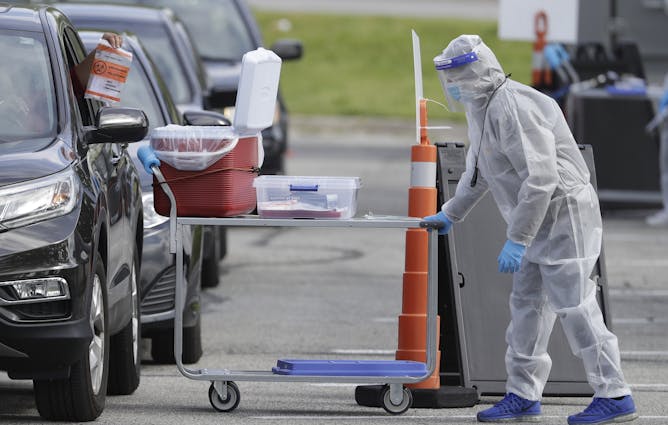|
|
|
|
When fighting a pandemic, it is important to have good data. How many people are infected? How deadly is the virus? Who is most vulnerable and what communities are hit hardest? These are critically important questions, but a severe shortage of coronavirus tests has hampered efforts to get accurate answers.
By randomly testing 3,600 people, a team of researchers from IUPUI was able to use a small number of tests to get the first statistically representative sample of an entire state. The team estimates that as of April 29, 2.8% of Indiana residents had been infected, a number 11 times higher than confirmed cases, and the fatality rate for COVID-19 is six times higher than the flu.
Also today:
|
Daniel Merino
Junior Editor: Science, Health, Environment
|

|
|

Random testing conducted in Indiana gives public health officials some of the most representative and accurate data to date.
AP Photo/Darron Cummings
Nir Menachemi, IUPUI
A team of researchers from Indiana University performed random testing for SARS-CoV-2 across the state. The results offer some of the most accurate data to date about important aspects of the virus.
|
Health
|
-
Rebecca Ashfield, University of Oxford
The experimental vaccine stimulates the creation of antibodies. Now we need to show that these effectively protect us from the coronavirus.
-
Jennifer A. Mallow, West Virginia University
Telehealth has seen massive increases in use since the pandemic started. When done right, remote health care can be just as effective as in-person medicine.
|
|
Politics + Society
|
-
Adrienne Jones, Morehouse College
Voters across the nation should prepare for similar circumstances in their communities – but there is still time for them to demand better from their officials.
-
John E. Finn, Wesleyan University
A constitutional law scholar says that the arguments made by anti-mask protesters that the Constitution protects their freedom to go maskless are just wrong.
-
Heather Schoenfeld, Boston University
Violence in the criminal-justice system isn't limited to police. It's time to pay more attention to violent deaths within state prisons.
-
Pamela S. Nadell, American University
Before presidential candidate Hillary Clinton, before Speaker of the House Nancy Pelosi, there was Congresswoman and firebrand Bella Abzug.
|
|
Education
|
-
Bob Spires, University of Richmond
Nearly every country in the world shuttered its schools due to COVID-19. Now, from Israel to Uruguay, many students are back in class, with varying degrees of success.
|
|
Environment + Energy
|
-
Cutler J Cleveland, Boston University; Alicia Zhang, Boston University; Jacqueline Ashmore, Boston University; Taylor Dudley, Boston University
Working from home has become the new norm for many during the pandemic. But it's an opportunity that divides along racial and economic lines – and isn't as beneficial to the environment as many believe.
|
|
Arts + Culture
|
-
Chauncey Maher, Dickinson College
Books, movies and records that seem to challenge racism also subtly advance the idea that progress shouldn't happen too quickly.
|
|
Most read on site
|
-
Andrew D. Hwang, College of the Holy Cross
There are about 2,000 billionaires in the world, controlling over $7.6 trillion. How does that compare to the income of an average American?
-
James M. Lang, Assumption College
Children will probably be OK, especially if their families make sure this elevated level of screen time doesn't turn into a long-term habit.
-
Laura P.W. Ranum, University of Florida
Amyotrophic lateral sclerosis, Lou Gehrig's disease, is a crippling, progressive neurodegenerative disease for which there is no cure. Now it seems that a diabetes drug may help some cases.
|
|
| |
| |
| |
| |
| |
| |
|
|
|
|
|
|
|